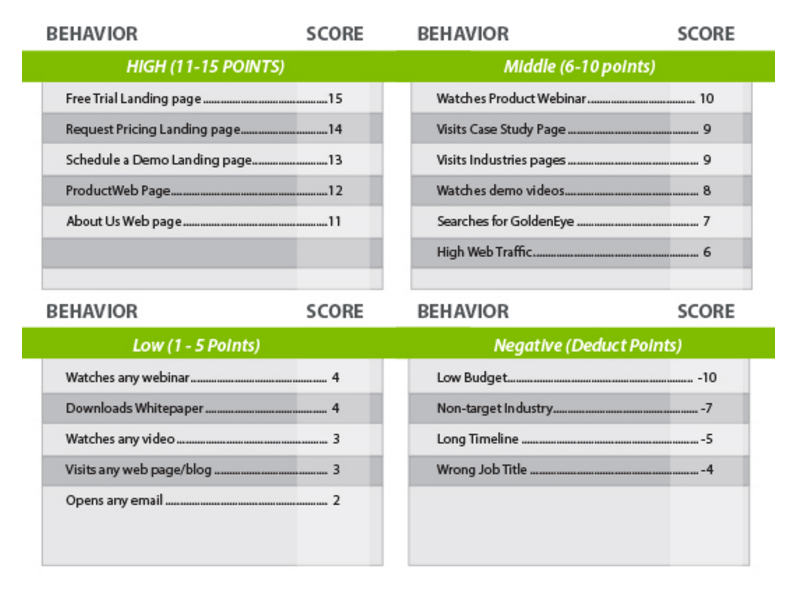tl;dr: Traditional lead scoring is inefficient in today’s economy. Dawn Poulos, VP of Marketing at Gliffy, has a few tips to help you boost your lead velocity rate.

As a marketing executive at a startup, I’m on a tight budget, and I’m under pressure to generate the demand that’s going to generate continuous MRR growth. Even so, MRR is not the SaaS metric I care about most. That honor goes to the less discussed Lead Velocity Rate, or LVR, brought to prominence by Jason Lemkin. Here’s what Jason has to say about it:
“MRR growth is great, but really that just tells you about the present – how you’re doing now. But if your leads are growing faster than your revenue, I can see the future growth. Being able to quantifiably track the velocity of qualified leads is going to be your best possible indicator as a CEO of where you’re going to be in the future.”
That’s my mandate here at Mattermark, to help build this incredible company to something much bigger than it is today. LVR tells me how I’m doing.
LVR is simply a measure of the growth in qualified leads & pipeline, month-over-month, every month. What Lemkin cares about is that there is a consistent formula and process for qualification, how that qualification is done, he says, is up to marketing. And therein lies the rub. In 2015, 80% of marketers reported that their lead generation efforts were only slightly or somewhat effective. 68% went on to say that increasing the quality of leads is their top priority for 2016. While Marketing’s processes and formulas for qualification may be consistent, they are also are wrong – or at best, incomplete.
I’m here to explain to you why that is. While there are a number of factors that play into lead qualification, I want to talk about the two issues that materially affect the accuracy and velocity of the Marketing Qualified Leads (MQLs) we send to Sales.
There is Too Much Emphasis On Behavior
Engagement and the interactions that leads have with your website, email campaigns, marketing assets and social accounts are incredibly important. However, as the above survey results illustrate, marketers are finding out that behavior can paint a misleading picture as to who is really qualified to become a purchasing customer.
Let me illustrate why this is. Pull up any article on lead scoring and you’ll inevitably find something like this as an example of what data points to use for scoring a lead:

Image Source
Looks good, right?
Let’s say two leads come in, Sam and Nick. Sam is an enthusiastic lead who registered for the product webinar, read two blog posts, and perused the ‘About Us’ page. Nick on the other hand, seems more of a tire kicker since he only watched a demo. According to a lead score based on behavior, Sam, at 27 points, is the clear Marketing Qualified Lead (MQL) and Nick, at only 8 points, requires more nurturing.
But how would those scores change if you included company data into your lead scoring system? For example, what if Nick’s company increased headcount by 50% over the past six months? Here’s an example of one that actually did:

 Growth means bigger budgets. Growth means that new technologies are needed to support a company’s trajectory. Yet in the lead scoring models advocated by most, none of this matters. Behavior trumps growth and Nick is still unqualified.
Growth means bigger budgets. Growth means that new technologies are needed to support a company’s trajectory. Yet in the lead scoring models advocated by most, none of this matters. Behavior trumps growth and Nick is still unqualified.
So while behavior tells us a lot, it doesn’t tell us the whole story. Cold, hard company facts give us context to behavior, for a far more accurate qualification formula.
You’re Waiting for Data When You Can’t Afford To
If you’re a fast growing SaaS company, post Series A, you have four to six quarters to get to $10M ARR. From there, it only gets harder, so sitting on your hands isn’t really an option. But that’s exactly what marketers do with lead scoring.
As demonstrated above, when we add company context to to user behavioral data, we’re able to improve the accuracy of our qualification. This is nothing terribly new as marketers regularly attempt to capture additional information through progressive profiling. Here’s a basic example:

Image Source
The problem with progressive profiling is that it’s a drawn out process that requires multiple website visits by leads and a willingness fill out additional forms. Or to put it more succinctly: time and friction, the two factors we want to decrease in the race against our competitors.
Progressive profiling has strong potential to yield deeper insights into the buyer’s journey, but time and friction is just bad process. When there is so much pressure for hyper-growth, marketers don’t have the luxury of waiting months, or even quarters, for their leads to provide them the contextual information needed for accurate qualification.
Today, a new wave of marketing tech vendors are using technologies such as machine learning, web crawlers and natural language processing to collect and categorize vital business information and expose that data through APIs. Here’s an example of some of these data points:

In an instant, and without additional time and friction, the contextual company data marketers need to more accurately qualify raw leads is available. This gives marketers the opportunity to use progressive profiling in less intrusive ways that subtly gathers valuable information to help Marketing and Sales personalize the experience. For example, question on business issues or key pain points.
Conclusion
The good news here is that little changes can have big impact. Here’s a five bullet case study on a small change one of our customers made to their lead qualification process using company data provided by Mattermark:
- The customer understood that once companies hit a certain number of employees, the need would arise for their software.
- So they tweaked their lead scoring formula to include Mattermark employee counts. Leads received a significant score increase when the companies they worked for hit a specific number of employees.
- The effect was that those leads became qualified much sooner than they would have just using behavioral data.
- Those MQLs converted to SQLs at a faster pace and a higher rate than they had ever previously experienced.
If you want to know about the types of business data that can help you better qualify leads, Mattermark has made their full database of companies available for free. Go to Mattermark and search for some of the companies that make up your leads an and see what additional intelligence and insights you can gain into them. A limited set of data points are available but you can easily unlock the full set of data with a free trial.
